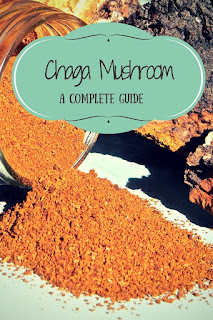How to Harvest and Process Chaga Mushroom
In this post I discuss how to obtain chaga and get it to a usable point. If you've already done so, check out my post on how to make chaga tincture here.
I am now selling Double Extracted Chaga Tincture! Visit my Etsy page: https://www.etsy.com/shop/StoneAxeHerbals?ref=l2-shopheader-name
We are also giving away a 1oz bottle of chaga tincture to one lucky winner!! Check it out here: http://stoneaxeherbals.blogspot.com/2016/02/chaga-tincture-giveaway.html
Identifying Chaga Mushroom:
Chaga is easy to identify and does not really have any look-alikes. Chaga almost always grows on birches, so if it's on a different tree the odds are it isn't what you're looking for. It is characterized by its crumbly, burnt looking black outer layer with a vibrant golden-orange interior.
Where to find it:
Chaga mushrooms grow primarily on birch trees (although it rarely can be found on elm, beech, and hornbeam) in the northern hemisphere, including the northern United States, Canada, Northern Europe, and Northern Asia. The easiest way to find it while hiking is to look for the large reddish-brown stains under the black fungus itself. Once you find one tree with chaga on it, look around, often times neighboring trees will have it as well.
How and When to Harvest Chaga:
 Chaga mushroom should only be harvested in the winter time after 20 consecutive days of temperatures below freezing. Do not harvest chaga when the sap is flowing in the trees (when the weather is above freezing in the spring, summer, and fall). If the sap is flowing in the tree, the chaga will have a much higher water content, reducing its medicinal value greatly and increasing the likelihood that it will spoil. Chaga should only be harvested off of live trees. Once the tree has died, the chaga also dies and loses its medicinal properties. Only mature chaga larger than your first should be harvested. A good test is to put your palm on the center of the piece of chaga you want to harvest, if your fingers touch the tree at all, it is too small. Overharvesting of chaga has been a serious issue as its use has gained popularity in the last several years. If you are planning on purchasing some be sure that your supplier follows ethical wild harvesting principles. If you want to harvest your own, experts suggest that you leave at least 20% of the growth on the tree. When I harvest I try to leave more like 50% to ensure there will always be a supply of this powerful medicine. If the tree has more than one growth, just harvest one. To remove the chaga from the tree, chip it off with a very sharp knife or hatchet. DO NOT cut into the tree, this will leave an open wound, making it susceptible for disease and pest infestation.
Chaga mushroom should only be harvested in the winter time after 20 consecutive days of temperatures below freezing. Do not harvest chaga when the sap is flowing in the trees (when the weather is above freezing in the spring, summer, and fall). If the sap is flowing in the tree, the chaga will have a much higher water content, reducing its medicinal value greatly and increasing the likelihood that it will spoil. Chaga should only be harvested off of live trees. Once the tree has died, the chaga also dies and loses its medicinal properties. Only mature chaga larger than your first should be harvested. A good test is to put your palm on the center of the piece of chaga you want to harvest, if your fingers touch the tree at all, it is too small. Overharvesting of chaga has been a serious issue as its use has gained popularity in the last several years. If you are planning on purchasing some be sure that your supplier follows ethical wild harvesting principles. If you want to harvest your own, experts suggest that you leave at least 20% of the growth on the tree. When I harvest I try to leave more like 50% to ensure there will always be a supply of this powerful medicine. If the tree has more than one growth, just harvest one. To remove the chaga from the tree, chip it off with a very sharp knife or hatchet. DO NOT cut into the tree, this will leave an open wound, making it susceptible for disease and pest infestation.Image that harvesting chaga is like cutting your. You dont want to cut too much off or else the you would be bald; it will grow back but it grows very slowly. Just because you are shaving your legs doesn't mean you should cut all the hair off your head either; you want to leave some so youre not totally hairless. You definitely dont want to cut your skin because it would be a pain to keep clean and bandaged and if you dont you could get a deadly infection. Its best to do it in the winter because then if you mess it up at least you can hide it under a hat until spring. And there's no point in doing it if you're already dead.
How to Process Chaga
 Okay, so you've got some chaga, now what? Well, two things need to happen; you need to dry it out and you need to break it up into smaller pieces. It doesn't matter what order you do this in. It needs to be dried, otherwise it could spoil. I like to leave whole chaga or smaller chunks of it near the woodstove for a couple of days, but you can also use a food dehydrator. You do not want the chaga to be heated too much, though, as this will reduce its medicinal value. Never put chaga in the oven. To break it up, I wrap it in a strong cloth or put it in a canvas grocery bag. Then I put it on concrete and simply beat on it with a hammer until it's in pea-sized pieces. You can also use a mortar and pestle. I then grind it using my great-grandmother's coffee grinder (below), but you could use a vita-mix or electric coffee grinder. If you don't own any of these, you can keep on with the hammer method until it is in very small pieces, but this takes a lot of effort and you will have to boil it longer for tea.
Okay, so you've got some chaga, now what? Well, two things need to happen; you need to dry it out and you need to break it up into smaller pieces. It doesn't matter what order you do this in. It needs to be dried, otherwise it could spoil. I like to leave whole chaga or smaller chunks of it near the woodstove for a couple of days, but you can also use a food dehydrator. You do not want the chaga to be heated too much, though, as this will reduce its medicinal value. Never put chaga in the oven. To break it up, I wrap it in a strong cloth or put it in a canvas grocery bag. Then I put it on concrete and simply beat on it with a hammer until it's in pea-sized pieces. You can also use a mortar and pestle. I then grind it using my great-grandmother's coffee grinder (below), but you could use a vita-mix or electric coffee grinder. If you don't own any of these, you can keep on with the hammer method until it is in very small pieces, but this takes a lot of effort and you will have to boil it longer for tea.
How to Make Chaga Tea
Finely Ground:
If you have finely ground chaga that is in a powdered form, simply put a tablespoon in a tea bag or strainer in your mug and pour a cup of boiling water over it. Allow it to steep for at least 10-15 minutes.
Course Ground:
Boil pea to half dollar sized pieces in water for at least an hour (1 TBS per cup of water). When I have this size I like to make a big pot of it and simply keep it on the woodstove, adding water as I take it out. I find that you can use these sized pieces several times and they will maintain their strength, just make sure that the color of the tea is still dark brown to almost black.
Pro tip: I like to steep conifer needles with my chaga for an extra boost of flavor and vitamin C. You can use any conifer except juniper (aka yew) or larch (aka tamarack).

Looking for some more resources about chaga? Check out these great books!
If you would like to purchase chaga I recommend getting it from Moutain Rose Herbs at this link:
http://edge.affiliateshop.com/
Consult your physician before use, especially if you are pregnant or nursing or are taking blood thinners. Keep away from children. I am not medically trained in any professional way. Use herbal remedies at your own risk.
This post was submitted to Murano Chicken Farm's Saturday Blog Hop. Check it out here:
http://www.muranochickenfarm.com/2016/02/simple-saturdays-blog-hop_27.html
Disclaimer: This blog is just my own opinion, nothing more. While I try my hardest, everything may not be completly accurate or complete. Sorry, I'm only human, so do not hold me accountable for anything you do to harm yourself or the world around you. I do make money from this blog (seriously not very much at all guys). If you click on any of the links in my blog I may make money from it. I'm not sponsored by any of these people I just honestly love these products and want to give you the resources to find them.




